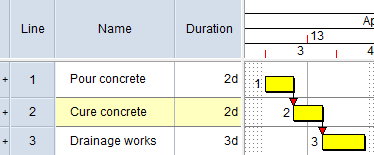'Middle to middle links' quality metric
Use the 'middle to middle links' metric to check the proportion of links that do not have lead/lag at both their start and their end. Depending on whether the lead/lag is positive or negative, this can mean that such links start and end in the middle of tasks. You may want to include this metric in a quality check to ensure that links with lead/lag at both ends are not used in a schedule.
In the following illustration, the link between tasks 1 and 2 has no lead/lag; the link between tasks 3 and 4 has lead/lag at the start only; and the link between tasks 5 and 6 has lead/lag at the end only. These links would pass this metric. The links between tasks 7 and 8 and tasks 9 and 10 have lead/lag at both ends. These links would fail this metric:

You can change the impact that this metric has on the weighted total result of a quality check by entering a factor by which the quality metric should be multiplied in the Weighting field. For the weighting to have any effect, a quality check must have more than one quality metric.
Pass and fail criteria
| Pass or fail? | Criteria |
|---|---|
| Pass |
A project passes this metric if the percentage of links that do not have lead/lag at both ends is greater than or equal to the pass boundary percentage.
For example, if the pass boundary was set to 100.00%, a project would pass this metric if 100.00% of links had no lead/lag, or had lead/lag on one end only. |
| Fail |
A project fails this metric if the percentage of links that do not have lead/lag at both ends is less than the fail boundary percentage.
For example, if the fail boundary was set to 95.00%, a project would fail this metric if less than 95.00% of links had no lead/lag, or had lead/lag on one end only. |
| Neither pass nor fail | If the percentage of links that do not have lead/lag at both ends falls between the pass and fail boundary, the result is neither a pass nor a fail, but somewhere in between. |
Suggested settings
- Pass boundary: 100.00%. A project will pass this metric if all links have no lead/lag, or have lead/lag on one end only.
- Fail boundary: 95.00%. A project will fail this metric if less than 95% of links have no lead/lag, or have lead/lag on one end only
The following table shows whether some example projects would pass or fail this metric using these settings:
| Percentage of links that have no lead/lag, or have lead/lag on one end only | Pass or fail? |
|---|---|
| 0.00% | Fail |
| 50.00% | Fail |
| 94.99% | Fail |
| 95.00% | Neither pass nor fail |
| 99.99% | Neither pass nor fail |
| 100.00% | Pass |
Does the metric force a project to be rescheduled?
No.
Suggested actions if a project fails this metric
If a project fails this metric, select the metric in the Quality Check Results dialog and click Show Failing Tasks to view the links that have failed the metric, together with the tasks at either end of the links.
You could take the following actions to remedy the failing links:
- Examine the links to determine whether it is appropriate for them to have lead time. If a link has inappropriate lead time, edit the link and remove the lead time.
- Examine the links to determine whether it is appropriate for them to have lag. If a link has inappropriate lag, edit the link and remove the lag.
- If it is appropriate for a link to have lag, consider removing the lag from the link and creating an additional task that represents the lag time. For example, if a 'Pour concrete' task is linked to a 'Drainage works' successor task by a link with 2d lag, with the lag representing the time it takes for the concrete to cure, consider removing the lag from the link and adding a 2d long task called 'Cure concrete' between the 'Pour concrete' and 'Drainage works' tasks, as illustrated below.
The link with lag:

Can be replaced with a 2d long task:
